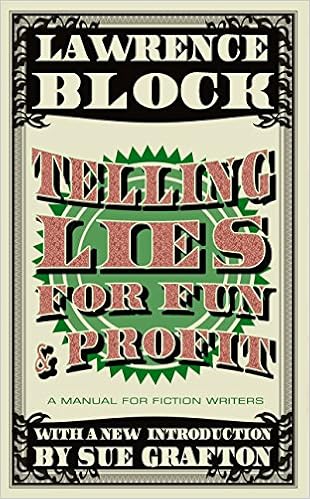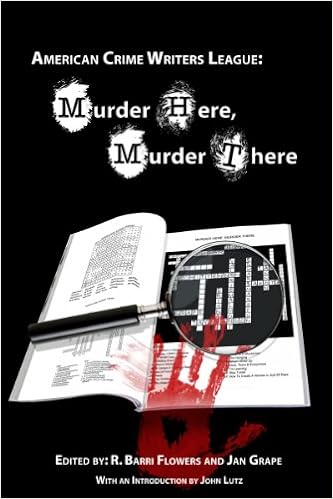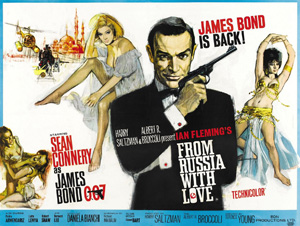Ngaio Marsh sold four stories to the Ellery Queen Mystery Magazine, and I mention this upfront, because it's the only other connection (albeit tenuous) that I can claim to her; I too have had stories appear in the same magazine.
| Ngaio Marsh's short stories in EQMM |
I Can't Find My Way Out (August 1946) Death on the Air (January 1948) Chapter and Verse: The Little Copplestone Mystery (August 1973) A Fool About Money (December 1974) |
 |
| A couple of Dames at the Savoy (Christie and Marsh) |
Ngaio Marsh's parents met in Christchurch. Her mother, Rose, was a New Zealander and an actress, and her father, Henry, was British and a bank clerk with an interest in the theatre. They were married in 1894 and Edith, their only child, was born the following year. An uncle fluent in Maori was asked to provide an indigenous middle name (a custom at the time, apparently), and he came up with "Ngaio", which is a Maori word for a type of tree, with the additional connotations of clever, methodical, and restless.

So, how do you pronounce Ngaio? And I have been asked. Being an authority on the New Zealand vocabulary and accent (because I be one), I can tell you it's pronounced Nigh-Oh [ /ˈnaɪ.oʊ/ ].
Marsh's childhood, from all accounts, was reasonably spiffing and splendid (we'll skip over the fact that she was bullied at school and for a time (10-14 years) was home-schooled). She read everybody. Ah... pause for a moment to imagine a life before the Internet, before television. Imagine summer afternoons in the countryside reading Kipling, Dickens, Henry Fielding, Smollett, Shakespeare, and Conan Doyle. You can just picture her, in Edwardian attire, basking on a blanket in a soft breeze, with a flask of lemonade, a half-eaten ham sandwich, and thoroughly absorbed in Smollet's The Adventures of Roderick Random (mark the name Roderick well).
In addition to reading, Marsh also had a taste for the theatre, like her parents, and while still in school she mounted several amateur theatrical productions. She also began writing: short stories and plays. At first, her audience was her school peers, but by her 20s, she was in print, with stories and poems appearing regularly in Christchurch's The Sun newspaper. She also had a strong passion for painting, and she graduated in 1917 with an Arts diploma (first-class honours) from Canterbury University College (Christchurch is located in the Canterbury province of New Zealand).
For the next ten years after graduation, until 1928, Marsh continued developing her talents as a writer: writing plays and working on a "New Zealand" novel. Together with a group of likeminded artists she formed "The Group" (a group, mostly women, with avant-garde leanings). And she found on-going employment with a handful of professional theatre companies. It was in this time that she "paid her dues" and learnt her theatre craft. In fact, had Marsh never written a single novel, she would still be recognized as one of the doyens of 20th Century New Zealand theatre. Indeed, my first introduction to her was in a theatre, when I was 14. I had joined an amateur repertory company (the other members were mostly adults), and I remember Marsh being spoken about with reverence on winter evenings over cups of hot tea and crumbly digestives (a type of cookie).
 |
| Marsh (in beret) with "The Group", 1936 |
In April 2012, the Alfred Hitchcock Mystery Magazine published my short story Pueri Alleynienses, and a friend asked me if the Latin title was a reference to Ngaio Marsh's detective, the principal character of all 32 of her novels, Roderick Alleyn. No, it wasn't, but then I discovered, unintentionally, that it was. My story was about two old men who, many years earlier, had attended Dulwich College in London. Pueri Alleynienses is the title of the Dulwich school song. It translates from the Latin as "Boys of Alleyn" (the founder of Dulwich College was Edward Alleyn). My interest in Dulwich had been based on the fact that Raymond Chandler had been a pupil there (1900-1905). In 1882, part of Dulwich College was annexed as a separate school, to be known simply as Alleyn's School, and it was at this school that Ngaio Marsh's father received an education, and from where she took a name for her character.
And a home for her character, too. London. Inspector Roderick Alleyn worked for Scotland Yard. He was British, a member of the gentry (his older brother was a baronet). He was an Oxford graduate, and had a background in the British army and the Foreign Service before he joined the Met. Almost all of Marsh's 32 books are set in England, with just four set in New Zealand, where Alleyn is either on secondment to the New Zealand Police, or is on holiday (Colour Scheme, Died in the Wool, Vintage Murder, Photo Finish). A fifth, Surfeit of Lampreys, starts out in New Zealand, but promptly returns to London and stays there.
Why London? Because in 1928, Marsh went to live there. Why? Probably because, like most other New Zealand artists and creatives (and even more so 80 odd years ago), New Zealand is a bit empty. Even today, the population is well under five million, spread out over a land mass equivalent in size to the United Kingdom, or California, and not a lot of people in that population could give a flying truck about the local arts scene. Unless it involves Peter Jackson and lots of loud noises.
Nowadays it's called going on The Big OE (Overseas Experience). Yes, there is actually a name for it: when young New Zealanders venture overseas to find fame and fortune, or to get a life. Nowadays, an OE could mean venturing anywhere: Spain, Norway, the US, South America; but until about 20 years ago, it meant only one thing: London. There are very few New Zealanders who work, or have worked, in the arts who haven't done it. Katherine Mansfield, Janet Frame, to name two others. Even I’ve done it. I lived in Soho for a year (before decamping for the continent). The Big OE is written into the DNA of many New Zealanders.
 |
| Marsh (1935) |
And then one wet winter's weekend in 1931, trapped indoors with nothing much else to do, a bored Marsh thought she would try her hand at a detective novel. She had been reading Sherlock Holmes mysteries since she had been a child, and she was au fait with the emerging detective genre (she had read Agatha Christie, Dorothy Sayers, et al). The Golden Age of Mystery Fiction had begun, and Marsh probably didn't realize it when she put pen to paper that weekend, but she was about to join it. Her first book, A Man Lay Dying was published three years later in 1934. Inspector Roderick Alleyn entered the minds of readers and found their favour, along with most critics'.
Marsh was back in Christchurch when the book went to print, having returned in 1932 to nurse her ill mother. She wouldn't return to Europe until the late 1930s, and from then on she largely made her home in New Zealand. The Big OE was over. If I was to write a movie script about Marsh, that's where I'd end it: The publication of her first book to great reception. The end. Roll credits. The rest of her life is largely a matter of bibliography and milestone. She wrote 31 more novels featuring Inspector Alleyn (about one every 1-2 years), cementing her place in the literary pantheon. She wrote numerous plays, short stories, articles, and three works of non-fiction, including an autobiography. And she dedicated the remainder of her time to her other love: theatre.
| Selected Milestones (not mentioned above)  |
1949 Penguin Books publishes the Marsh Million, in which one million copies of ten of her titles (i.e. 100,000 x 10) were released on the same day. 1950 Marsh produces her favourite play (Pirandello's Six Characters in Search of an Author) at the Embassy Theatre in London. It's interesting that this was her favourite play, given her love of Shakespeare. It's an oddball piece of theatre (in my tainted opinion -- I sat through a million amateur performances of it in the 1980s as a lighting designer). I much prefer Rod Serling's Five Characters in Search of an Exit, if you know your Twilight Zone. 1951 An Ellery Queen Mystery Magazine reader's poll votes Marsh one of the best mystery writers currently active. 1963 Receives an honorary doctorate in literature from Canterbury University. 1967 The Ngaio Marsh Theatre opens. It is a 400-seat proscenium-arch theatre on campus at the University of Canterbury (currently closed due to earthquake damage). Opening night was a Ngaio Marsh produced production of Twelfth Night. 1967 Death at the Dolphin nominated for the Edgar Award 1969 Marsh produces A Midsummer's Night's Dream, starring Sam Neill. 1973 Tied up in Tinsel nominated for the Edgar Award 1978 South Pacific Pictures (a NZ television company) produces four feature-length adaptations of the New Zealand-set novels, starring George Baker as Inspector Alleyn. Click here to watch online: Died in the Wool 1990-94 The BBC produces The Inspector Alleyn Mysteries, adapting nine of the novels. 2010 The Ngaio Marsh Award is established by journalist Craig Sisterson. The award is given each year to the best crime novel written by a citizen (or resident) of New Zealand. |
 Roderick Alleyn
Roderick AlleynRoderick Alleyn's initials are RA. As a painter, Marsh would have known that the initials "RA" after an artist's name stand for Royal Academician, i.e. an artist elected (to the distinguished title) by members of the Royal Academy of Arts. I mention this purely as an observation.
Agatha Troy
Agatha Troy first appears in Artists in Crime (1938). She is a famous painter. She is Marsh's version of Agatha Christie's Ariadne Oliver -- i.e. a character through which the author can vicariously live in the story. Troy reappears in the later books and becomes Alleyn's wife.
| Ngaio Marsh's Mystery Books |
1. A Man Lay Dead (1934) 2. Enter a Murderer (1935) 3. The Nursing Home Murder (1935) 4. Death in Ecstasy (1936) 5. Vintage Murder (1937) 6. Artists in Crime (1938) 7. Death in a White Tie (1938) 8. Overture to Death (1939) 9. Death at the Bar (1940) 10. Surfeit of Lampreys (1941) [US: Death of a Peer] 11. Death and the Dancing Footman (1942) 12. Colour Scheme (1943) 13. Died in the Wool (1945) 14. Final Curtain (1947) 15. Swing Brother Swing (1949) [US: A Wreath for Rivera] 16. Opening Night (1951) [US: Night at the Vulcan] 17. Spinsters in Jeopardy (1954) [US: The Bride of Death (abridged, 1955)] 18. Scales of Justice (1955) 19. Off With His Head (1957) [US: Death of a Fool] 20. Singing in the Shrouds (1959) 21. False Scent (1960) 22. Hand in Glove (1962) 23. Dead Water (1964) 24. Death at the Dolphin (1967) [US: Killer Dolphin] 25. Clutch of Constables (1968) 26. When in Rome (1970) 27. Tied Up in Tinsel (1972) 28. Black As He's Painted (1974) 29. Last Ditch (1977) 30. Grave Mistake (1978) 31. Photo Finish (1980) 32. Light Thickens (1982) |
Don’t ask me to name a favourite Marsh. I've only read two of them, and a long time ago at that. The word tardy is applicable. In researching this little post, I turned up the fact that the bafflingly titled book on my parent's bookshelf, Surfeit of Lampreys, is considered her best book. I've left a memo on my desk to get a copy and read it.
Light thickens, and the crow
Makes wing to th' rooky wood.
Light Thickens was Marsh's final novel (1982). The title is taken from a line in Shakespeare's Macbeth (quoted above), and a principal element of the book concerns the theatrical taboo of "the Scottish play". Marsh completed the book shortly before her death. The Golden Age was over. The last queen was dead.
www.StephenRoss.net
Photos: The Christchurch Press, The NZ National Library





















![Pageflex Persona [document: PRS0000037_00019] Pageflex Persona [document: PRS0000037_00019]](https://blogger.googleusercontent.com/img/b/R29vZ2xl/AVvXsEgNBBRth-kt8oKPFJ8l8E5zo7QX_dp6Cx88inRZWahp3j5grv5_s2hDlo_e8cMe2BXDcHGR6bcFI8eBaBqDgtrCm3dL8GfkngJ_AnHozOabjzrJM4DxAFLIpxJW7q1GlSCfHcxqXnL6CSM/?imgmax=800)






)











